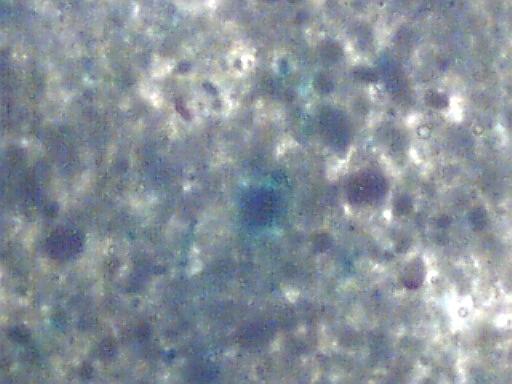|
|

 Green Dye and Additives in Henna Powder Catherine Cartwright-Jones c 2004 Kent State University
This is picture of
henna powder, with bottled lemon juice added, stirred, placed on a
microscope slide, allowed 5 minutes to set, then photographed at 60
x through the microscope. The vivid
green chunk at the center of this page is spreading green are
artificial green
dye, a coal tar-derived dye, added to make the product more
"eye-appealing".
This is known as "polishing" the henna in the Indian henna industry.
The presence of green dye is irrelevant to the stain. Henna with
this green dye is often sold as being "fresher" and "higher quality",
though the presence of green dye in henna indicates neither freshness
nor quality. The presence of this dye and is confirmed and identified in: "Study of Quality Characteristics of Henna", Chourasia, Sardar, Patil, Mathew,Kanpur, India: Essential Oil Association of India, 1989 "Major contaminants /adulterants in henna leaves are stems, dirt, plant waste and other leaves. However in case of henna powder admixture of dyed sand is observed. It has been reported that for adulteration, finely ground local sand is used. It is first dyed with auramine yellow (C.I. No. 41000) and then green with diamond green (C.I. No. 20440). This is then mixed with pure henna powder. The extent of adulteration is variable in accordance with the price of the powder reflected therein. "Added azo dyes were not found
in henna leaf samples, but yellow
and green coal tar dyes were observed in powdered samples. As mentioned
earlier, this may be due to the presence of (the afore mentioned dyed
sand).
Unlike Lawsone, the natural color of henna, these added synthetic
azo-dyes
used for dyeing the sand or for polishing the leaves may have an
adverse
effect on the skin. It is, therefore, necessary to ensure that these
artificial
dyes are not there in the product marketed.
The dark red/purple spots in
the picture above may be myrobalan or madder root. They are not
henna. Myrobalan, madder root, and alkanet root are added to
henna to boost stain in an otherwise mediocre henna, or to make the
stain tend to red tones rather than brown.
The Henna Page Main Index http://www.hennapage.com/henna/mainindex.html *"Henna,
the
Joyous Body Art"
the Encyclopedia of Henna Catherine Cartwright-Jones c 2000 registered with the US Library of Congress TXu 952-968 All text and images on this page copyright 2003 all rights reserved Catherine Cartwright-Jones The Henna Page |
